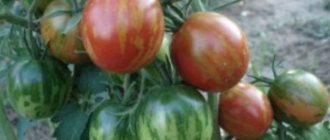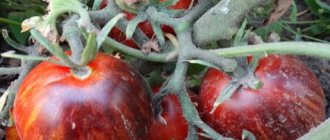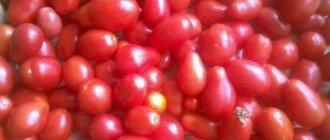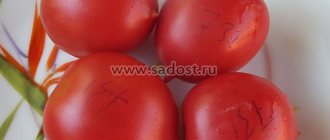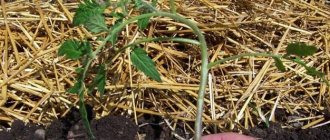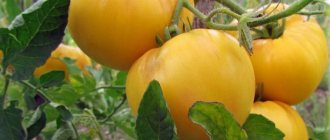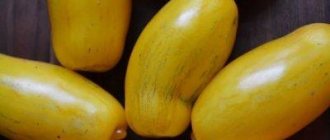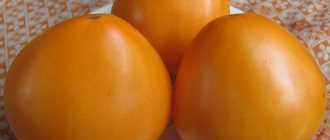Main characteristics and description of the variety
The Mongolian dwarf tomato is a low-growing variety that can reach a height of 0.3 m.
It differs from other varieties of tomatoes in that it is not erect, but spreads along the ground.
Up to 4-5 strong stems are formed on the bush, and also in the process of further growth, a large number of stepsons are formed, which actively branch. As a result, Mongolian dwarf bushes can be 0.9-1.1 m in diameter.
Photo of Mongolian dwarf tomato
The main difference of this variety is the growth feature of the bushes:
when the shoots reach a height of 0.2 m, they begin to bend and subsequently grow parallel to the ground, creeping along it.
Growing stepsons also grow along the ground. The Mongolian dwarf variety is early ripening
– the first fruits from the bushes can be collected at the beginning of summer. But due to the fact that the bushes of this variety develop branching stepsons during the growth process, on which ovaries also appear, fruiting of this tomato can continue until the autumn cold snap.
Tomato Mongolian dwarf - video
The stems of this variety are strong and strong; pubescence is clearly visible on them. The foliage is narrow, elongated, medium in size with sharp tips, rich emerald color. The ovaries mainly appear on the upper side of the stems.
Important!
Since fruiting also occurs on the stepsons of this variety, they should not be removed. Usually, only those stepsons that extend too far beyond the garden bed are removed.
Creeping shoots cannot be tied up; they should grow quietly along the beds on the ground.
By taking good care of these bushes, you can ensure that clusters of fruit appear in almost all leaf axils. Each cluster produces no more than 6 fruits.
Photo of ripe Mongolian dwarf tomatoes
Ripe tomatoes of this variety have a round shape, at the stage of technical maturity they are light green, and at the stage of full ripening they have a rich red color. The skin is dense, medium thickness, smooth, slightly shiny. The pulp is slightly compacted and has no light veins. The taste of these tomatoes is sweetish with a characteristic sourness. The first tomatoes grow large - up to 140-150 g in weight. And the latter fruits are already much smaller, they are rarely large and can weigh no more than 100 g.
Each fruit has many small seed chambers, their number can reach 6-8 pieces, the number of seeds in each is small.
EXCELLENT VARIETIES OF TOMATOES!
Tomato Raspberry Flame F1 Tomato BATYANYA
Tomato Mongol dwarf calmly tolerates periods of drought, but it is better to adhere to the watering regime.
On a note!
Tomatoes, even lying on the soil, are practically not subject to rotting, do not crack or burst.
The harvested crop tolerates transportation well over any distance and can be stored for a long time in a cool place.
Ripe fruits have a universal purpose - they can be eaten fresh, added to salads and snacks, or canned.
Harvesting the crop
The plant bears fruit for a long time: from May to October, until autumn frosts. The first fruits of the Mongolian dwarf tomato variety can be harvested upon reaching milk maturity; they ripen easily in warm conditions. The main harvest is harvested in mid-August. The fruits retain their marketable appearance on the bushes for a long time. Even lying on cold ground, they do not rot or crack (in dry climates). And yet, experts recommend picking berries as they ripen, avoiding prolonged aging to avoid diseases and speed up the ripening of the crop as a whole.
Article Rating
Advantages of the variety
The main advantages of the Mongol dwarf tomato variety include:
- originality;
- good yield;
- Mongol dwarf bushes do not require the procedure of pinching and gartering the stems;
- The variety is versatile - it can be grown in beds in the garden or in film greenhouses and greenhouses. The Mongol dwarf tomato is resistant to temperature fluctuations;
- fruiting can continue until autumn frosts;
- low bushes do not break under gusts of strong winds.
Creeping tomato Mongolian dwarf - video
The main disadvantages of this tomato include
:
- The variety does not develop well on acidified or heavy soils. Also, you should not grow it in regions where it is too humid or hot;
- it is necessary to control the irrigation regime - stagnation of moisture in the soil should not be allowed;
- a tomato of this variety takes a long time to take root after planting; active growth of bushes begins a few weeks after planting Mongolian dwarf plants in open ground;
- The Mongol dwarf tomato is currently not yet included in the State Register, so specialized stores may not have seeds of this variety. But planting material can be ordered online on the agro website;
- not everyone likes the taste of ripe fruits of this variety.
Fruits and yield
The fruits on the bush grow heavy - up to 150-200 g (the first tomatoes can reach 300 g) . The shape is round, angular-ribbed, fleshy. There are legends about the productivity of this variety, because tomatoes grow on all shoots and in every leaf axil. Those who grew the Mongolian dwarf say that they removed up to 10 kg of tomatoes from the bush.
Because tomatoes grow inside a dense layer of leaves, they are less susceptible to pests . The fruits have a thick skin, so they are easily transported.
Tomatoes of this variety have few taste characteristics . Standard tomato taste. But this is a positive characteristic for a tomato with early fruiting, since usually early tomatoes are often tasteless. If the summer is warm, sweetness predominates in the fruits; if it is cold, sourness prevails.
Planting seedlings, transplanting into greenhouses and open ground
Initially, the Mongolian dwarf tomato was intended for cultivation in eastern Russia, but according to reviews from vegetable growers, it can be grown well in many Russian regions, including the Urals and Siberia. It’s just better not to plant it in areas with a humid climate.
Photo of tomato seedlings Mongolian dwarf
In the south of Russia, the seeds of the Mongolian dwarf tomato variety are planted directly in open ground. Up to 5 seeds are planted in each hole. After several leaves appear on the sprouted seedlings, only strong sprouts should be left in each hole, the rest should be carefully pinched at ground level.
In regions with harsher climates, this tomato is grown only by seedlings. Seed material is planted in containers at home. Planting should be carried out at such a time that already flowering seedlings are planted in the soil in mid-May, and the first fruits are harvested in the first ten days of July.
Photo of preparing tomato seedlings for transplanting
To plant Mongolian dwarf tomato seeds for seedlings, you should use sandy soil with a slightly acidic reaction. It can be purchased at gardening stores or prepared at home.
When purchasing seed material, you should pay attention to their shelf life - it is 2 years. Seeds that have expired have poor germination.
BEST VARIETIES OF VEGETABLES:
Potato Gypsy Cucumber Gosha F1 Pepper Gemini
Before planting, purchased seeds do not require additional preparation; they just need to be soaked for germination.
A nutrient substrate is poured into containers, in which shallow grooves are made. Before sowing the seeds, water the soil. The distance between adjacent seeds is about 1 cm. The seeds are sprinkled with soil on top and sprayed with a spray bottle.
To create a greenhouse effect, the containers should be covered with glass on top and placed in a warm room until sprouts appear. Mongol dwarf tomato seeds usually germinate within a week.
Tomato seedlings are watered with filtered water when the soil dries out. After several leaves appear on the seedlings, the picking procedure can be carried out. Seedlings are planted in separate containers. Such seedlings are planted in open ground when they are at least 1.5 months old. Sufficiently mature seedlings usually have at least 7 leaves.
The place for planting Mongol dwarf seedlings is prepared in advance. In the autumn, organic matter is added to the digging. After the snow melts, 3 tbsp should be added to the soil. l. superphosphate, 1 tbsp. l. ammonium sulfate and 25 g of any potassium salt.
Tomatoes Mongolian dwarf, correct planting - video
The area for planting tomatoes should be well illuminated by the sun and protected from gusts of wind.
Seedlings are planted in beds in two rows, the distance between which is 0.55 m. There should be the same distance between neighboring plants.
When planting, plants need to be buried a couple of centimeters deeper than they grew in cups. Watering is carried out before and after planting. The next watering is carried out after a few days. After watering, add a layer of mulch to the beds.
Features of cultivation
- Due to the low growth of the bush, the fruits lie on the ground. To protect them from slugs and other pests, it is important to properly prepare the soil. You can use a special black covering material or you can use plywood, boards, straw or other material to fence the fruit.
- In order to get a rich and early harvest, it is necessary to transfer the seedlings to the soil as early as possible. It is enough to simply stick the bush into the soil and cover it with some kind of oilcloth.
- Pay attention to the acidity of the soil; too acidic is detrimental to this variety.
Planting a Mongolian dwarf in a greenhouse is not always suitable. This variety is afraid of excess moisture, and a poorly ventilated greenhouse can only harm the seedling bushes.
- Many gardeners prefer to plant this variety directly into bare soil. They claim that this way the harvest is twice as large as when planted in a greenhouse.
- Make sure to leave a large gap when planting seedlings. Do not forget that the Mongolian dwarf will already grow about a meter around itself.
- Plant seedlings at the rate of one bush per half square meter. If you plant too close, you will cut off the side shoots. Which can subsequently lead to a decrease in yield.
You can start sowing seeds as early as mid-February. It is customary to plant seedlings in mid-May. With this planting calendar, you will be able to taste the first fruits in early June.
But you can get the first tomatoes even earlier. To do this, transplant the seedlings at the end of February into a large container, so you can taste the fruits at the end of May. There are no special manipulations with growing seedlings; they are grown according to accepted standards.
Other interesting varieties:
- Abakan pink
- Banana legs
Further care for Mongolian dwarf tomatoes
This variety should be watered moderately so that the moisture does not stagnate.
in the soil the Mongolian dwarf does not like excessive moisture. Typically, this variety is watered once a week, and only in hot, dry times can the number of waterings be increased.
A couple of weeks after planting the seedlings in a permanent place, you should water the bushes with a light solution of potassium permanganate to prevent the development of diseases.
The beds for planting this variety are made higher, since the plants will spread along the ground. Usually, film or planks are placed under this variety to prevent damage to the fruit by pests living in the soil.
Fertilizing tomatoes Mongolian dwarf
This variety of tomato should be fed strictly “at the root”, and drops of the solution should not fall on the foliage.
The feeding schedule is as follows:
- the first - 12-14 days after planting the plants in the beds;
- the second - before the active formation of ovaries;
- the last one is in a couple of weeks.
Usually alternate application of organic matter and mineral fertilizers.
Reviews from those who planted the Mongolian dwarf tomato variety
Valentina, 64 years old, Moscow region: I planted this variety for the first time last season in a greenhouse. There was no special time to care for these plants, only watering and periodically applying fertilizers. The yield surprised me - the fruits grew large, but a little sour. True, they lay in the room for a while and became sweeter. Now I will plant it constantly.
Anna, 38 years old, Volgograd region: I would like to note the amazing vitality of this variety - it grows even with minimal watering. I bought Mongol dwarf seeds online and will collect my own seeds in the future. I apply nitrogen-containing fertilizers to the bushes; I don’t do any pinching. The yield is quite high.
This variety is quite productive, unpretentious and does not require special care. It can be grown not only in garden beds, but also in greenhouses.
The main feature of the variety is that it spreads along the soil and does not require pinching or garters, which makes caring for plants easier.


